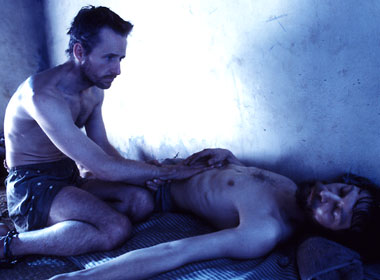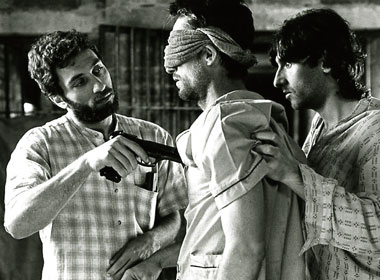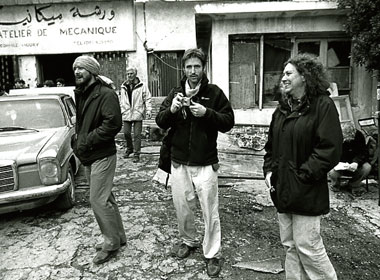BLIND FLIGHT - OVERVIEW
What particularly attracted me about Brian Keenan and John McCarthy’s story of their ordeal as hostages in Lebanon was the capacity and openness of feeling that two men had to uncover in themselves in order to survive and grow. A capacity which women all too often complain that we fail to show!
My own interest had long been in movies that could work in the gap between ‘art’ and ‘popular’ cinema. When Brian and John entrusted me with the story I felt I’d got something that perfectly suited this. It could combine a profound story and creative integrity with audience appeal. The subsequent success of their 1.5 million-selling book accounts An Evil Cradling (1992) and Some Other Rainbow (1993) augured well.
The natural home for the project was Channel Four which, since its inception in 1982, had been central to the renaissance in British independent filmmaking. Under David Rose’s aegis in the 1980’s it had launched the feature film careers of directors like Neil Jordan and Peter Greenaway at a time when ‘art’ cinema was still a staple, even viable part of our culture. Now under David Aukin since 1990, it was to have growing international success with films like Trainspotting, The Madness Of King George and The Crying Game.
Blind Flight in fact took 13 tortuous years from concept to screen. The whys and wherefores for its long drawn out realisation from a ‘star’ vehicle to a low-budget directorial debut of great spareness - time and money permitted me less than 3 shots average per scene - is told in my Independent On Sunday article at the time Flying Blind.
A central reason for its long gestation was that, as director Nic Roeg pointed out, I’d unwittingly written “a director’s script”. Its detailed vision of the story left little room for other directors interested in a very different take on the story. Nic was a particularly encouraging advocate of the idea of me directing the film. But it was only in late 1999, after almost six years unsuccessful trawling for established directors, that this idea became viable - indeed a last resort!
Legendary US director John Huston famously said that directing is 70% about getting the casting right. Nic highly recommended Celestia Fox as casting director, and Celestia was to play a pivotal role in getting Blind Flight off the ground with myself as director. Through her I was able to get Joe Fiennes, fresh from the success of Shakespeare In Love, and Robert Carlyle, 'hot' since the success of Trainspotting, to commit to star as John McCarthy and Brian Keenan. This provided me with a bankable cast package to take to Ken Loach producer Sally Hibbin, whom David Aukin had recommended.
By then (2002) the advent of TV multi-channelling and the internet were already beginning to affect film financing, distribution and audiences. Even for a recognised specialist in low-budget, ‘difficult’ productions like Sally finance raising for Blind Flight was a real struggle. The horizons shrank so dramatically that, if she hadn’t successfully concluded financing at the end of that year, the film would probably never have got made.
Because of the protracted time involved in raising production finance Robert Carlyle had to pull out but we were able to get Ian Hart to soon replace him. With the unusually extended commitment to the film by Joe, Sally was able to get funding from the UK Film Council for a film sample ‘pilot’ which we made with Joe and Ian. When Joe had to also pull out eventually because of other film commitments Linus Roache replaced him.
After obtaining cornerstone backing from the Film Council Sally then managed to patch together more central financing from a variety of other sources. Through her colleague Scottish producer Eddie Dick another key wedge of money was obtained from Scottish Screen. And Irish producer David Collins obtained cross-border financing from the Irish Film Board and the Northern Ireland Film And Television Commission.'
The film's UK distributor Optimum Releasing obtained national distribution for Blind Flight both on the commercial and art-house circuits which, although limited, was an achievement at a time when barely 50% of British movies were getting theatrical distribution. But Optimum's excellent launch campaign used up all their small prints & advertising budget for the film so that, when Blind Flight opened to very good reviews, including many 4-stars across the board (see Reviews), they were unable to exploit them in the kind of follow-through advertising that's vital to building audience momentum.
Despite Blind Flight’s considerable critical success and timeliness (see New York Times film review) - the abuses of detainees by US military in Iraq were in the headlines - and a very good reception at film festivals like the Tribeca in New York, where Ian Hart won Best Actor Award, it was seen by US distributors as an ‘art’ film. And by then the ‘art’ film was feeling the squeeze of the new, far more conservative order. Perhaps the film’s human scale treatment of Brian’s and John’s ‘terrorist’ captors was also a deterrent in the then still very pro-Iraq War climate.
I’d long felt that DVD would be a vital market for Blind Flight, particularly in the UK given the ‘niche’ market of the story’s books’ 1.5 million readership. But for reasons beyond my knowledge and control the DVD promotion marketing didn’t work out as I’d hoped. Apart from some ill-prepared recordings of some 'bonus' material to accompany the film on its DVD version and the failure to feature interviews with Brian Keenan and John McCarthy, a notable potential selling point to all the aficionados of the story, I saw little or nothing in the media put out about its DVD launch and circulation.’
Blind Flight's very good ratings for its BBC1 premiere in October 2006 - it led the late-night ratings with 700,000 staying up until 1.00am to watch it - pointed to the film's potential DVD marketability which I'd envisaged.
The lack of follow-through, indeed utter silence, that followed Blind Flight’s release and TV transmissions - no one said they’d seen it anywhere subsequently; it seemed to vanish into some black hole for ‘lost’ movies - left me for years feeling that I’d failed as a filmmaker to do justice to Brian’s and John’s extraordinary story. It was only after getting screenings for the film almost 20 years later in 2023 and the plaudits it then received (see here) that I felt the monkey of self-doubt finally lift off my shoulder.


